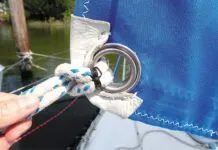Refinishing hulls, decks and masts has been revolutionized by epoxy primers and two part polyurethane top coat material. Their adhesive quality, durability, longevity and like-new gleam make their cost and/or your DIY commitment justifiable. However, there is a difference in how these coatings behave on different substrates. And when applied over aluminum, steel or wood some of the application techniques must be altered.
Take, for example, how mast paint preparation affects the process. Reader Lawrence Smith wrote us that as part of his refit the paint was removed by soda blasting. Prior to blasting, all hardware had to be removed and this raises some additional concerns. Over time, hardware like spinnaker pole tracks, external mainsail tracks and gooseneck fitting fasteners can galvanically corrode binding the threads of stainless steel fasteners so tightly that threaded fasteners end up shearing rather than loosening. Often, some hard-to-twist fasteners destroy the aluminum threaded hole during removal. The blaster might prefer hardware removal, but this can result in more problems and more repairs.
Most pros carefully consider the spar’s age and the condition of each key piece of hardware as they decide what to remove and what to leave in place. Most prefer to avoid the removal of securely fastened, good mast tracks and other mechanically attached, high-load fittings. Time, and the chloride ion ever present in sea air, bond stainless fasteners to aluminum. They understand how much damage can be done when a well seated fastener is over torqued during a removal attempt.
In cases where there’s no sign of extensive oxidation or corrosion adjacent to fasteners, and the external tracks they secure are holding their share of the load, they consider the old mantra about leaving well enough alone. But when oxidation around track fasteners or other hardware is extensive and removal makes sense, new impact drill/driver tools and tight-fitting bits deliver increased success rates. Even so, the threaded hole in an aluminum spar is often damaged in the process.
One solution to this problem is to have the fastener holes plug welded and the track realigned so that the new holes can be drilled between the old, plugged ones—a costly endeavor.
When it comes to coating decisions, a lot depends upon the condition of the spar surface itself. In cases such as the abrasive blasted spar mentioned above, there can be concerns about caustic soda residue remaining on the surface. With more abrasive grits, there’s also the issue of the micro pockmarks left from blasting. In either case, it makes sense to clean via compressed air and/or water blasting. This should be followed by a dish soap and water wash and a vigorous rinse that will clear away any oil residue left by the blasting compressor.
Once completely dry, wipe down the spar(s) with Awl Grip wipe down solvent prior to applying a very light coat of their Prime Wash CF (a chromate free coating). This etch primer chemically bonds tenaciously with aluminum, but has very little shear strength, so it’s important to follow the less-is-more rule and keep the single coat thin and even (2 mils). When dry, without sanding, overcoat with Awl Grip epoxy 545. If mini pockmarks, caused by the blasting, can still be seen, follow up with a second coat of 545. When the epoxy primer has cured, sand with 220 and you’re ready for the first coat of LPU topcoat. Two coats (roll and tip) are good, three is even better. If possible, allow two to three weeks for the coatings to fully cure prior to reattaching hardware.




































This site has two kinds of users. Subscribers and people who you would like to subscribe. Please do the work necessary to separate the workflow between these two groups. Subscribers do not like to be continuously challenged with excessive logins and promotions for products that we are already paying for.
Thank you
Roger Bigger